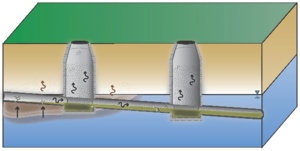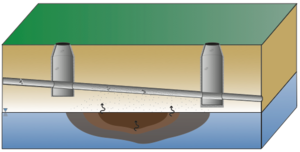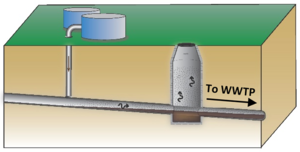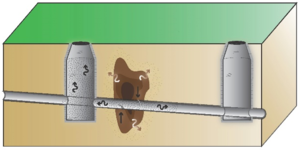User:Debra Tabron/sandbox
The term “vapor intrusion” or “VI” refers to the migration of volatile organic compounds (VOCs) from a subsurface source into an overlying building. Preferential pathways for VI are specific migration routes that support higher contaminant flux, or discharge, into a building compared to transport through bulk soil. Sewers and other utility conduits or tunnels are an important type of preferential pathway that can result in VI when VOC vapors migrate through the interior of the conduits into buildings.
Related Article(s):
CONTRIBUTOR(S): Matthew Zenker, Dr. Shaily Mahendra, and Dr. Michael Hyman
Key Resource(s):
- Conceptual Model for Sewer/Utility Tunnel VI[1]
- Investigation protocol for sewer/utility tunnel VI[2]
Contents
Introduction
A utility tunnel or utility corridor is a passage built underground or aboveground to carry utility lines such as electricity, water, and sewer pipes. Communication utilities like fiber optics, cable television, and telephone cables are also sometimes carried. They may also be referred to as a services tunnel, services trench, services vault, or cable vault. Utility tunnels are often installed in large military facilities as well as industrial plants and large institutions such as universities, hospitals, research labs, and other facilities managed in common. They are not generally installed in residential areas. A directly buried utility, such as an electrical or gas line, is not a utility tunnel.
Although not historically evaluated in a systematic manner, sanitary sewers and utility tunnels have been identified as important preferential transport pathways for VI at a growing number of sites[3][4]. They should, therefore, be considered during planning and implementation of VI assessment programs. Recognizing sewer/utility tunnel VI early in the site characterization process should help avoid wasted investigation efforts and delays in response actions where those are needed.
| Key terms and concepts: | |
| Vapor intrusion | Migration of VOCs from any subsurface source into an overlying building. |
| Conventional, or standard, vapor intrusion | Migration of VOCs from a subsurface source into an overlying building by advection and/or diffusion through soil (i.e., not through a preferential pathway). These mechanisms for vapor entry into buildings can also be viewed as “soil gas intrusion.” Conventional VI refers to the conceptual model that has historically and most commonly been utilized to describe VOC flux from the subsurface into buildings. |
| Preferential pathway | A migration pathway from a subsurface source that supports higher VOC flux/discharge into a building compared to transport through bulk soil. This general term typically includes features such as elevator shafts and dry wells that can enhance vertical transport from a VOC source below the building into the building, and features such as sewers and utility tunnels that can enhance both lateral and vertical transport of VOCs. The term “sewer/utility tunnel vapor intrusion” or “sewer/utility tunnel VI” refers to VOC flux from the subsurface into buildings though this specific preferential pathway. |
| Sewer/utility tunnel vapor intrusion (sewer/utility tunnel VI) | A sewer or utility tunnel that supports higher VOC flux/discharge into a building compared to transport through bulk soil. The VOC flux is through the interior of the sewer line or tunnel. Sewer/utility tunnel vapor intrusion has also been referred to as “pipe VI”[5]. Sewers or utility tunnels can enhance VOC transport into a building from a VOC source that is laterally separated from the building (i.e., not located directly below the building). |
Conceptual Model
The standard VI and sewer/utility tunnel VI conceptual models are illustrated in Figure 1. One important difference is that, for sewer/utility tunnel VI, the building may be located outside the footprint of the subsurface contaminant source. In general, for standard VI, potentially affected buildings are situated over the source.


| Higher Risk Scenarios | Lower Risk Scenario |
|---|---|
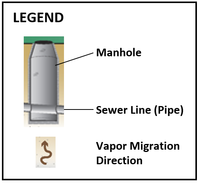
|
Not all sites are equally at risk for sewer/utility tunnel VI. In general, higher risk sites are those where contaminated groundwater or soil gas has infiltrated into the underground utility line. This occurs most commonly at sites with sewers or utility tunnels that intersect shallow impacted water tables, sites with discharge of contaminated groundwater into sanitary sewer lines, or sites with sewer lines or utility tunnels that intersect strong contaminant sources (e.g., nonaqueous phase liquid (NAPL)) in the unsaturated zone (Figure 2).
Elevated VOC concentrations in sewer vapor can be found at both higher and lower risk sites. At higher risk sites, these elevated VOC concentrations can be present over a larger area, extending beyond the footprint of the subsurface contamination. Standard VI investigations typically focus on areas above this footprint. To factor in sewer/utility tunnel VI, it is important to identify higher risk sites early in the VI investigation process so that potential impacts outside the footprint are not overlooked.
Investigation Approaches
Basic screening for sewer/utility tunnel VI can be done at any site by determining if the site has higher or lower risk for this pathway. If the site has higher risk, initial testing can be done by sampling vapor from manholes (Figure 3; Also add link to video) above the core of the groundwater plume to get an understanding of the level of VOCs that may be present.
Follow-up testing may be needed depending on the initial results. Vapor intrusion guidance documents generally do not provide screening values for sewer vapor samples. However, results from ESTCP Project ER-201505 show that sewer to indoor air attenuation is similar in magnitude to sub-slab to indoor air attenuation. This suggests that sub-slab screening values can also be used to evaluate sewer vapor results[2]. VOC vapors can migrate from sewers into buildings through a variety of different entry mechanisms that are difficult to predict (Figure 4). As a result, if sewer vapor concentrations exceed screening levels, then indoor air testing may be needed to determine the presence or absence of VI.

At lower risk sites, a specific, early focus on sewers or utility tunnels is generally not needed. A standard VI investigation that includes indoor air testing can be conducted with evaluation of sewers/utility tunnels only if indicated by the building-specific investigation results (e.g., if elevated indoor air concentrations in one section of the building suggest a specific vapor entry point).
Many indoor air testing techniques utilized to assess conventional vapor intrusion are also applicable to buildings potentially impacted by sewer/utility tunnel VI. Techniques that focus on VOC source identification (e.g., indoor VOC sources vs. vapor entry points) include on-site analysis, compound-specific isotope analysis, and building pressure cycling.
Mitigation
If sewer/utility tunnel VI is identified, mitigation approaches include preventing contaminants from entering the sewer or utility (e.g., by rerouting or lining the sewer), ventilating the line, or correcting plumbing defects. Examples are provided in Table 1.
| Mitigation Method | Reference |
|---|---|
| Depressurization of sewer line | Nielsen et al., 2014[7] |
| Replacement of collapsed portion of sanitary sewer line and installation of an interior liner to prevent infiltration of LNAPL | Macklin et al., 2014[8] |
| Sewer line relocation to avoid intersecting contaminated groundwater plume | ERM, 2017[9] |
Various options including:
|
Nielsen and Hivdberg, 2017[10] |
| Installation of check valves (backflow preventers) in sewer lateral lines connecting residences to the sanitary sewer line containing elevated petroleum vapor concentrations. Note: for VI mitigation, the check valve must control both liquid and vapor flow (e.g., Checkmate inline check valve). |
Jarvela et al., 2003[11] |
| Sewer line ventilation | Riis et al., 2010[12] Nielsen and Hivdberg, 2017[10] ERM, 2017[9] Holton and Simms, 2018[13] |
| Sewer line repair | Viteri et al., 2018<ref>Viteri, C. R.; Richman, B.; Vitouchkine, A.; Armen, M. A.; Miller, A., 2018. Rapid, Real-time TCE Measurements of Sewer Headspace: Characterizing Spatial and Temporal Variability. AEHS 28th Annual International Conference on Soil, Water, Energy, and Air, San Diego Report.pdf
SummaryStorm and sanitary sewers, electrical and communications conduits, and other tunnels can serve as preferential pathways, in some cases allowing vapor to enter buildings. Sites at higher risk for VI from preferential pathways include sites where contaminated groundwater enters the sewer or where the conduit passes through a concentrated VOC source area. Monitoring results indicate that sewer to indoor air attenuation is similar in magnitude to sub-slab to indoor air attenuation, suggesting that sub-slab screening values can also be used to evaluate sewer vapor results. Mitigation approaches from sewers and tunnels include preventing contaminants from entering the conduit, ventilating the line, or correcting plumbing defects.
References
See Also |
